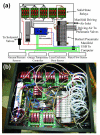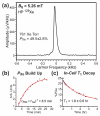XeNA: an automated 'open-source' (129)Xe hyperpolarizer for clinical use
- PMID: 24631715
- PMCID: PMC4011489
- DOI: 10.1016/j.mri.2014.02.002
XeNA: an automated 'open-source' (129)Xe hyperpolarizer for clinical use
Abstract
Here we provide a full report on the construction, components, and capabilities of our consortium's "open-source" large-scale (~1L/h) (129)Xe hyperpolarizer for clinical, pre-clinical, and materials NMR/MRI (Nikolaou et al., Proc. Natl. Acad. Sci. USA, 110, 14150 (2013)). The 'hyperpolarizer' is automated and built mostly of off-the-shelf components; moreover, it is designed to be cost-effective and installed in both research laboratories and clinical settings with materials costing less than $125,000. The device runs in the xenon-rich regime (up to 1800Torr Xe in 0.5L) in either stopped-flow or single-batch mode-making cryo-collection of the hyperpolarized gas unnecessary for many applications. In-cell (129)Xe nuclear spin polarization values of ~30%-90% have been measured for Xe loadings of ~300-1600Torr. Typical (129)Xe polarization build-up and T1 relaxation time constants were ~8.5min and ~1.9h respectively under our spin-exchange optical pumping conditions; such ratios, combined with near-unity Rb electron spin polarizations enabled by the high resonant laser power (up to ~200W), permit such high PXe values to be achieved despite the high in-cell Xe densities. Importantly, most of the polarization is maintained during efficient HP gas transfer to other containers, and ultra-long (129)Xe relaxation times (up to nearly 6h) were observed in Tedlar bags following transport to a clinical 3T scanner for MR spectroscopy and imaging as a prelude to in vivo experiments. The device has received FDA IND approval for a clinical study of chronic obstructive pulmonary disease subjects. The primary focus of this paper is on the technical/engineering development of the polarizer, with the explicit goals of facilitating the adaptation of design features and operative modes into other laboratories, and of spurring the further advancement of HP-gas MR applications in biomedicine.
Keywords: Hyperpolarization; Laser-polarized xenon; Lung imaging; MRI; Optical pumping.
Copyright © 2014 Elsevier Inc. All rights reserved.
Figures







References
-
- Goodson BM. Nuclear magnetic resonance of laser-polarized noble gases in molecules, materials, and organisms. J Magn Reson. 2002;155(2):157–216. - PubMed
-
- Bifone A, Cherubini A. Hyperpolarised Xenon in Biology. Prog Nucl Magn Reson Spectrosc. 2003;42(1-2):1–30.
-
- Albert M, Cates G, Driehuys B, Happer W, Saam B, Springer C, Wishnia A. Biological Magnetic Resonance Imaging Using Laser Polarized Xe-129. Nature. 1994;370:199–201. - PubMed
Publication types
MeSH terms
Substances
Grants and funding
LinkOut - more resources
Full Text Sources
Other Literature Sources
Research Materials
Miscellaneous

